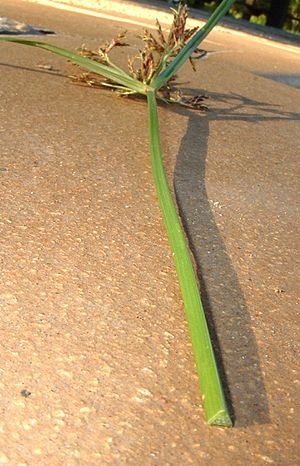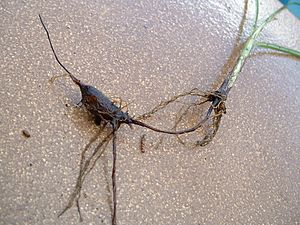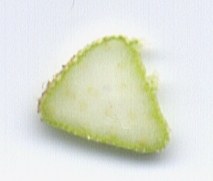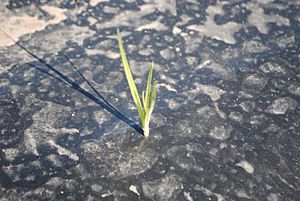Coco-grass facts for kids
Quick facts for kids Coco-grass |
|
|---|---|
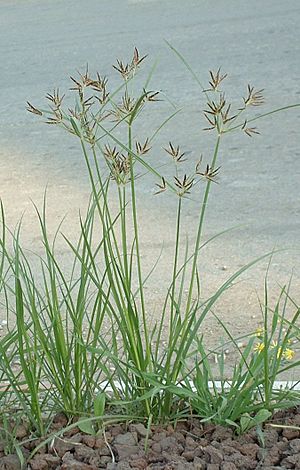 |
|
| Conservation status | |
| Scientific classification | |
| Genus: |
Cyperus
|
| Species: |
rotundus
|
| This article contains special characters. Without proper rendering support, you may see question marks, boxes, or other symbols. |
Coco-grass, also known as purple nut sedge or nut grass, is a type of plant called a sedge. Its scientific name is Cyperus rotundus. This plant originally comes from Africa, southern and central Europe, and southern Asia.
The name Cyperus comes from the ancient Greek word kyperos. The word rotundus is Latin, meaning "round." This name likely refers to the plant's round tubers.
Coco-grass is a perennial plant, which means it lives for more than two years. It can grow quite tall, sometimes reaching up to 140 centimeters (about 55 inches). People call it "nut grass" because its underground parts, called tubers, look a bit like small nuts. However, they are not true nuts in a botanical sense.
Like other sedges, coco-grass has leaves that grow in groups of three from the base of the plant. These leaves are usually about 5 to 20 centimeters (2 to 8 inches) long. The stems that hold the flowers have a unique triangular shape.
The flowers of coco-grass have both male and female parts. Each flower has three stamens (male parts) and a pistil (female part) with three stigmas. The flowers grow in clusters called inflorescences, which have three to eight spikes. After flowering, the plant produces a three-sided fruit called an achene.
When coco-grass plants are young, they first grow white, fleshy rhizomes (underground stems) in chains. Some of these rhizomes grow upwards and form a bulb-like structure. From this bulb, new shoots and roots appear. Other rhizomes grow sideways or downwards, forming dark reddish-brown tubers or chains of tubers.
This plant prefers dry places but can also grow in moist soil. You often find it in empty lots or in farm fields.
Contents
A Look at Coco-Grass History
Scientists believe that ancient human ancestors, called hominins, might have eaten coco-grass tubers. This was during a time called the Pliocene epoch.
Evidence of C. rotundus has been found in human teeth from an ancient site in central Sudan. This site, called Al Khiday, dates back to before 6700 BC. It continued to be used until the Meroitic Kingdom, around 300–400 AD. Some researchers think that eating coco-grass might have helped prevent tooth decay in the Meroitic people. This is because the plant can stop the growth of certain bacteria that cause cavities.
In ancient times, C. rotundus was also used in ancient Egypt, Mycenaean Greece, and other places. People used it for its pleasant smell and to help clean water. Famous ancient Greek doctors like Theophrastus, Pliny the Elder, and Dioscorides used it as both medicine and perfume.
How People Use Coco-Grass

Coco-grass has many helpful uses. In tropical areas, it has been a main source of carbohydrates for people who hunt and gather food. In some farming cultures, it has even been a "famine food," eaten when other food is scarce.
Traditional Medicine Uses
In traditional Chinese medicine, C. rotundus is seen as a very important herb for balancing the body's energy, known as qi.
The plant is also mentioned in an ancient Indian medical text called the Charaka Samhita, from around 100 AD. Today, in Ayurvedic medicine, the plant is called musta. It is used for things like fevers, problems with the digestive system, and painful periods.
In the Middle East, people traditionally used roasted tubers or hot ashes from burned tubers for wounds, bruises, and boils. Herbalists from both Western and Islamic traditions have described its uses. They used it to help with stomach issues, to encourage menstruation, and in soothing plasters.
The tubers' ability to fight bacteria might have protected teeth from decay. This was seen in people living in Sudan 2000 years ago. Less than 1% of their teeth showed signs of decay. This is interesting because these people were likely farmers. Farmers often had more tooth decay because their grain-rich diets could lead to more bacteria in the mouth.
Modern Discoveries and Studies
Scientists have found several chemicals in C. rotundus. One interesting chemical is rotundone. This chemical was first found in the tubers of this plant. Rotundone is what gives black pepper its spicy smell and certain wines their peppery taste.
Extracts from the leaves and tubers of Cyperus rotundus can help other plants grow new roots. These extracts contain natural plant hormones called auxins and other helpful compounds. These substances encourage cuttings and seedlings to grow roots.
Coco-Grass as Food
Even though the tubers can taste a bit bitter, they are safe to eat and have good nutritional value. Humans have eaten parts of this plant between the Mesolithic and Neolithic periods. The plant is rich in carbohydrates. In some parts of Africa, people eat it when there is a shortage of food.
The tubers are also an important food source for migrating birds, such as cranes. They provide essential minerals and trace elements.
Sleeping Mats
People also use the well-dried coco-grass to make mats for sleeping.
Coco-Grass: An Invasive Plant
Cyperus rotundus is known as one of the most invasive weeds in the world. It has spread to tropical and temperate regions everywhere. It's even called "the world's worst weed" because it causes problems in over 90 countries and affects more than 50 different crops.
In the United States, you can find it from Florida all the way north to New York and Minnesota, and west to California. In Cambodia, it is a major weed in farm fields.
When coco-grass grows in a field, it greatly reduces how much crop can grow. This is because it competes strongly for water and nutrients in the soil. It also releases chemicals from its roots that are harmful to other plants. This is called allelopathy. It also causes problems in ornamental gardens.
It's very hard to get rid of coco-grass because it has a strong system of underground tubers. It is also resistant to most herbicides (weed killers). It's even one of the few weeds that can grow through plastic mulch.
If you try to pull coco-grass by hand, the roots often break, leaving tubers in the ground. New plants quickly grow from these leftover tubers. Ploughing a field can make the problem worse. This is because it spreads the tubers around, and even small pieces of tubers can grow into new plants. Also, the tubers can survive tough conditions, making the plant very difficult to remove. In traditional farming in Southeast Asia, hoeing does not remove the plant completely, leading to fast regrowth.
Most herbicides can kill the leaves of the plant, but they often don't affect the root system or the tubers. Some herbicides like Glyphosate can kill some tubers, but you usually need to apply them many times. Another chemical, Halosulfuron-methyl, can control nut grass after repeated uses without harming lawns. Coco-grass does not grow well in shaded areas. Also, a chemical called 2,4-D can slow its growth in pastures and mulch crops.
Images for kids
See also
 In Spanish: Juncia real para niños
In Spanish: Juncia real para niños




